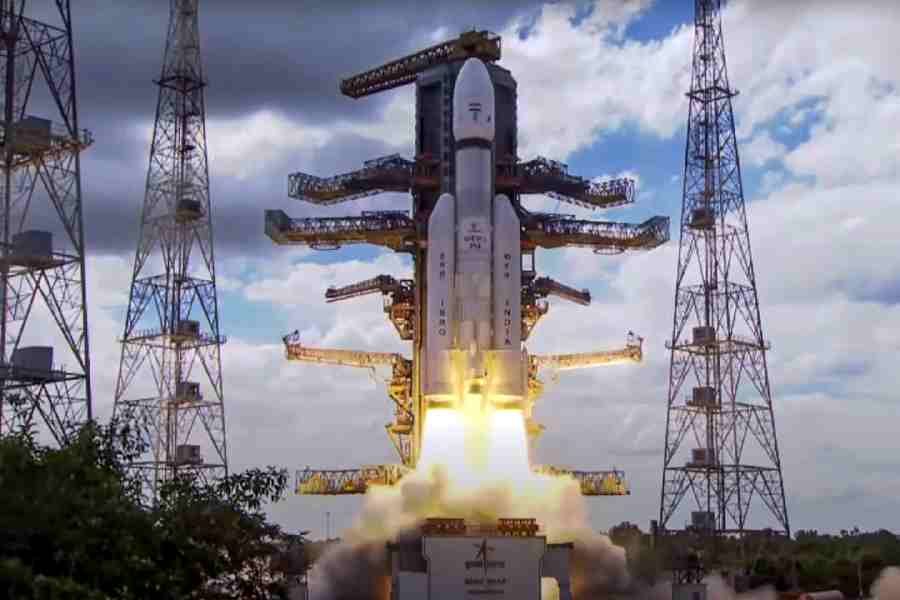A giant rocket rose from India’s Sriharikota island spaceport on Friday and ferried the Chandrayaan-3 spacecraft into an orbit around the Earth to start a 40-day journey, intended to climax with a soft landing near the lunar south pole.
The 43m tall Launch Vehicle Mark-3 (LVM3) rocket, more than half the height of the 72m Qutb Minar, blasted off at 2.35pm, spitting orange-white flames and smoke as it climbed into a blue sky, and released the spacecraft 16 minutes later 170km above the Earth.
“Our dear LVM3 has put the spacecraft into its precise orbit around Earth — 170km by 36,500km was its intended orbit and it is precisely there,” said S. Somanath, chairman of the Indian Space Research Organisation (Isro), who tracked the launch from the Sriharikota control centre.
Friday’s launch — the seventh successful mission of the LVM3 since its maiden flight in 2014 — will bolster confidence in the reliability of the home-grown rocket that Isro also plans to use for its planned human spaceflight mission, officials said.
Engineers at the Isro Telemetry Tracking and Command Network (Istrac) in Bangalore will monitor and direct the journey of Chandrayaan-3. The journey will involve multiple orbit-raising manoeuvres around the Earth in the coming days to place the spacecraft in a lunar transfer trajectory that will take it near the Moon.
The Chandrayaan-3 spacecraft — a propulsion module and a lunar lander with a lunar rover — will approach the Moon by mid-August.
Istrac engineers will then execute orbit-lowering manoeuvres to achieve a 30km by 100km orbit. The propulsion module will then release the lander for a slow descent to the surface.
“All our spacecraft health parameters are normal, including the power generation in both the propulsion module and the lander module,” P. Veeramuthuvel, project director for Chandrayaan-3, said in Sriharikota minutes after the launch.
“Many critical events are lined up, including Earth-bound manoeuvres, insertion into the (lunar transfer) trajectory, deboost manoeuvres, separation of the lander, and the powered descent for the soft landing.”
Isro officials have said they expect the landing on August 23 or 24.
A document released by Isro this week outlining the Chandrayaan-3 mission indicates there will be four orbit-raising manoeuvres while the spacecraft is in orbit around the Earth, and four orbit-lowering manoeuvres after it goes into orbit around the Moon.
Isro officials on Friday underscored the significance of the successful launch of the LVM3, formerly called the Geosynchronous Satellite Launch Vehicle Mark-3, the heaviest rocket in Isro’s stable, powered by a home-grown cryogenic engine that uses liquid oxygen and liquid hydrogen.
“This is the ideal vehicle for the Gaganyaan mission,” said S. Unnikrishnan Nair, director of the Vikram Sarabhai Space Centre, Thiruvananthapuram, referring to Isro’s planned human spaceflight mission that seeks to launch and return a space capsule with two or three astronauts.
“Some of the changes that we’re incorporating for Gaganyaan we’ve implemented here,” he said.
Chandrayaan-3 is Isro’s third lunar mission, with its lander and rover carrying payloads for studies to probe lunar geology and the chemical and mineral makeup of the lunar surface and rocks in an unexplored region about 650km from the lunar south pole.
“We expect this to be a game-changer mission -- novel scientific experiments on the Moon and the LVM3’s success are allowing us to inch towards the Gaganyaan mission,” said Anil Bhardwaj, director of the Physical Research Laboratory, Ahmedabad, an Isro centre that built some of the payloads.
The Chandrayaan-1 orbiter had detected signatures of water on the Moon. And while the Chandrayaan-2 lander and rover crashed in 2019, its orbiter module performed well, helping Isro acquire high-resolution images of the lunar surface that the space agency has used in planning the Chandrayaan-3 landing.
Multiple Isro centres and dozens of industries have contributed to building both the LVM3 and the Chandrayaan-3 spacecraft. An academic team at the Sona College of Technology, Salem, delivered a critical device called the stepper motor used in the LVM3’s cryogenic engine.












